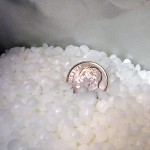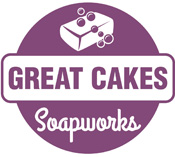Making Lotion
 I’ve been making a lot of lotion lately, and thinking about how far I’ve come in learning this craft. I am NOT an expert by any means, but I have had quite a bit of practice. If you are thinking about trying your hand at formulating, I’ll do my best to guide you in the process.
I’ve been making a lot of lotion lately, and thinking about how far I’ve come in learning this craft. I am NOT an expert by any means, but I have had quite a bit of practice. If you are thinking about trying your hand at formulating, I’ll do my best to guide you in the process.
First, I’m going to start by describing what lotion is. This may seem simple, but I don’t think I ever really thought about it before I started making it. Lotion is an emulsion between water-soluble and oil-soluble ingredients. All you need for a basic lotion is some water, oils, an emulsifier, and a preservative. Most people can’t just go to the store and buy an emulsifier and preservative. They have to be ordered from a supplier who specializes in lotion formulating. Some soap supply stores have started carrying these items as well.


So what is an emulsifier? Most of them are waxy substances, usually flakes or pellets, that are added to the oil soluble ingredients of the lotion and create an emulsion when the oil and water soluble ingredients are combined. There are two that I am currently using. The first is called Polawax, otherwise known simply as “emulsifying wax”. It’s highly stable and easy to work with. The other one is called OlivEm 1000 (INCI name: Cetearyl Olivate (and) Sorbitan Olivate). It’s derived from olive oil, and I’ve been using it in the facial moisturizer that is currently being tested. It has also proven to be easy to work with, and gives a very light, cushiony feel to the moisturizer. There are LOTS of different emulsifiers out there, but the one I would recommend for a beginner is the emulsifying wax.
If you are wondering whether or not you really need a preservative for your lotion, the answer is most definitely YES! Preservatives must be used in any product that contains water-soluble ingredients. If it has water in it, it has the potential to grow nasties. All kinds of nasties. Nasties you can see – like a big ol’ fuzzy mold, and nasties you can’t see – like bacterias that can cause infections if introduced to broken skin. There are a whole host of chemical preservatives available. I discussed some of these in my post about the preservative I chose for the facial moisturizer – which happens to be all-natural. I’ve decided to use it for my regular lotions as well. Read more about preservatives.
One of the reasons I say that I am not an expert lotionmaker, is that the chemistry behind it is rather daunting to me. There is a system called the HLB System (Hydrophile – Lipophile Balance) which is the ratio of oil soluble and water-soluble portions of a molecule. (I’ve lost you already, haven’t I?) Each ingredient is assigned a value from 0-20 that is supposed to help you figure out a formula for your lotion, and to predict how the emulsifier will behave. I have no clue how this works. Your eyes are probably glazed over as well. But that’s not all! There’s also the cationic, anionic, and nonionic behavior of the ingredients that has me baffled. Suffice it to say that I can work within a recommended range of percentages to come up with a pretty good formula.
Next lesson: Preparations for Making Lotion
lotion making tutorial
Page with Comments
Comments are closed.

Hey, Amy. I’m about out of my face stuff and I thought I’d ask you what you use? or make? What do you recommend?
Jessica’s last blog post..Wordless Wednesday
Hi, Great work, I love reading your blog. I have a one question…maybe you can help me:)! I was trying to make my own lotion at home and I thought i did a good job until 3 days later when my lotion got really thick? It was not like that in the beginning( when i made it). I want my lotion to have a stabilized texture, but dont know what to add!
Thanks
Mag
Hi Mag – Lotion will generally set up thicker overnight as it cools to room temperature. You can actually add some water or other liquid to thin it down. However, you will need to re-heat it on a double boiler until it becomes nearly liquid again, and heat the water to the same temp so that the lotion doesn’t separate as it cools. I don’t know how much to tell you to add since I don’t know the size of your batch, but keep good notes, and the next time you make it, you can add that extra liquid up front. If you heat it past the recommended temperature for your preservative, you will need to add more of that as well. Unfortunately, you won’t know the final consistency until it cools back down.
Thanks so much!
Thank you very much for this whole tutorial!
It seems to be very difficult for beginners to find a solid source of information and to really find a good recipe to start off with (my first batch was terrible!) – so thanks for all the info here! 🙂
HI amy, May I ask what preservative you use with the lotion? Ive used leucidal lotion in several of my lotions.
@Melizza – I’ve been using tinosan for most of my lotions. It’s easy to work with, and is a natural preservative that doesn’t require a high percentage to be effective.